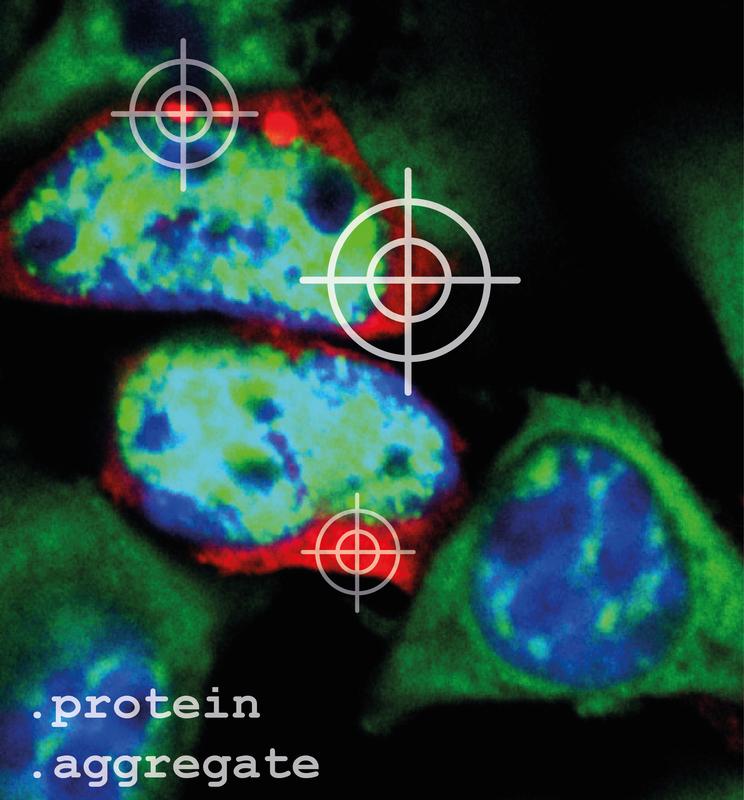Why nerve cells die

To visualize protein aggregates (red) under the microscope, they have to be stained. The cellular nucleus was stained blue and the mRNA, the construction manual for proteins, was stained green. Andreas Woerner © MPI of Biochemistry
Proteins consist of long chains of amino acids and function in cells like small machines. To be able to fulfill their function proteins have to assume a predetermined three-dimensional structure. In healthy cells there is a large variety of folding helpers and extensive quality control machinery. Misfolded proteins are either repaired or rapidly degraded. If this occurs inadequately, or not at all, proteins will clump together, form aggregates and harm the cell.
Protein aggregates are associated with many neurodegenerative diseases including ALS, Alzheimer’s, Parkinson’s and Huntington’s Disease. How exactly aggregates harm cells is however still unknown. In 2013 several groups in Martinsried formed the ToPAG consortium (http://www.topag.mpg.de) to address this question, and can now report their first success. Scientists in the lab of Prof. Hartl, a world-renowned expert on protein folding, have demonstrated that the location of the aggregates determines the fate of the nerve cells.
Together with Konstanze Winklhofer and Jörg Tatzelt from the Ruhr-University Bochum, the researchers have expressed artificial aggregation prone proteins as well as Huntington’s disease-causing mutants of the protein huntingtin in cultured cells. Both types of protein accumulate in large protein deposits.
“It came as a big surprise to us that the direction of the proteins to the cytoplasm instead of the nucleus resulted in more soluble, but also more toxic aggregates”, says Mark Hipp, a group leader in the department of Ulrich Hartl and leader of the study. The protein deposits in the cytoplasm blocked the transport of RNA and correctly folded proteins between the nucleus and the cytoplasm. It seems that the sticky surfaces of the aggregates can sequester important proteins and thereby inactivate them.
“We have detected multiple components of the cellular transport machinery inside the aggregates. This results in the depletion of these factors from the cell, and, like a machine with missing parts, the cell is then unable to function properly”, explains Andreas Woerner the first author of the study.
Once the blueprint for all proteins, the RNA, is trapped within the nucleus, protein synthesis cannot progress, and the cells deteriorate. It is not completely clear why the nuclear aggregates are less harmful, but the researchers have evidence that the nuclear protein NPM1 plays a central role in shielding these aggregates.
“The results of this study bring us researchers and physicians one big step further”, summarizes Mark Hipp. “Only if we understand how aggregates damage cells is it possible to develop appropriate countermeasures in the future.”
Original publication:
C. Woerner, F. Frottin, D. Hornburg, L. R. Feng, F. Meissner, M. Patra, J. Tatzelt, M. Mann, K. F. Winklhofer, U. Hartl, M. S. Hipp: Cytoplasmic protein aggregates interfere with nucleo-cytoplasmic transport of protein and RNA. Science, January 2016
DOI: 10.1126/science.aad2033
Contact:
Dr. Mark S. Hipp
Department of Cellular Biochemistry
Max Planck Institute of Biochemistry
Am Klopferspitz 18
82152 Martinsried
Germany
E-Mail: hipp@biochem.mpg.de
www.biochem.mpg.de/hartl
Dr. Christiane Menzfeld
Public Relations
Max Planck Institute of Biochemistry
Am Klopferspitz 18
82152 Martinsried
Germany
Tel. +49 89 8578-2824
E-Mail: pr@biochem.mpg.de
www.biochem.mpg.de
http://www.biochem.mpg.de/en/news – More press releases of the MPI of Biochemistry
http://www.biochem.mpg.de/hartl – Website of the Research Department “Cellular Biochemistry” (F.-Ulrich Hartl)
Media Contact
All latest news from the category: Life Sciences and Chemistry
Articles and reports from the Life Sciences and chemistry area deal with applied and basic research into modern biology, chemistry and human medicine.
Valuable information can be found on a range of life sciences fields including bacteriology, biochemistry, bionics, bioinformatics, biophysics, biotechnology, genetics, geobotany, human biology, marine biology, microbiology, molecular biology, cellular biology, zoology, bioinorganic chemistry, microchemistry and environmental chemistry.
Newest articles

Bringing bio-inspired robots to life
Nebraska researcher Eric Markvicka gets NSF CAREER Award to pursue manufacture of novel materials for soft robotics and stretchable electronics. Engineers are increasingly eager to develop robots that mimic the…

Bella moths use poison to attract mates
Scientists are closer to finding out how. Pyrrolizidine alkaloids are as bitter and toxic as they are hard to pronounce. They’re produced by several different types of plants and are…

AI tool creates ‘synthetic’ images of cells
…for enhanced microscopy analysis. Observing individual cells through microscopes can reveal a range of important cell biological phenomena that frequently play a role in human diseases, but the process of…





















